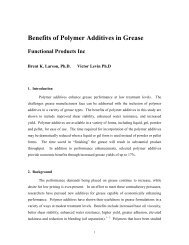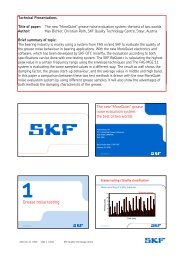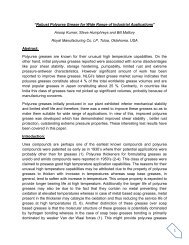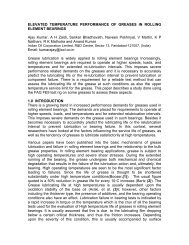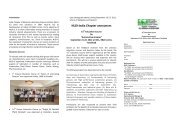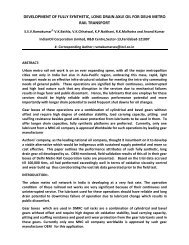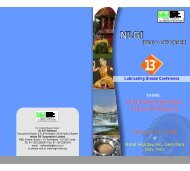Molybdenum Disulfide in Greases - A Review - (NLGI) - India Chapter
Molybdenum Disulfide in Greases - A Review - (NLGI) - India Chapter
Molybdenum Disulfide in Greases - A Review - (NLGI) - India Chapter
You also want an ePaper? Increase the reach of your titles
YUMPU automatically turns print PDFs into web optimized ePapers that Google loves.
spac<strong>in</strong>g (and weak Van der Waals bond<strong>in</strong>g) between S-Mo-S layers and the favorabledistribution of electrons on the constituent atoms. <strong>Molybdenum</strong> disulfide is thermally stable<strong>in</strong> vacuum or <strong>in</strong>ert environments, but <strong>in</strong> air or oxygen it beg<strong>in</strong>s to oxidize to MoO 3 atapproximately 400 o C.MoS 2 is used as a boundary lubrication additive <strong>in</strong> virtually all grease thickener types andconsistencies where high loads, low speeds, high temperatures and stop-start conditions exist.The ma<strong>in</strong> lubricant sectors <strong>in</strong> which MoS 2 greases are used are transportation (automotiveand rail), <strong>in</strong>dustrial, m<strong>in</strong><strong>in</strong>g construction and agricultural and military/aerospace.Pastes are a special form of greases that conta<strong>in</strong> >50% lubricat<strong>in</strong>g solids. These products areused as problem solv<strong>in</strong>g materials, break-<strong>in</strong> aids and anti-seize compounds.In fluid lubricants such as gear oils, MoS 2 dispersions can be effectively used to reducefriction, wear and bulk oil temperature <strong>in</strong> the boundary lubrication conditions found <strong>in</strong> wormgears, helical gears and hypoid gears.Solid film lubricants conta<strong>in</strong><strong>in</strong>g MoS 2 are firmly bonded to slid<strong>in</strong>g surfaces and are able toprovide low friction and low wear without the presence of an oil or a grease. These coat<strong>in</strong>gscan be applied by several techniques <strong>in</strong>clud<strong>in</strong>g burnish<strong>in</strong>g, imp<strong>in</strong>gement, sputter<strong>in</strong>g and res<strong>in</strong>bond<strong>in</strong>g.The most common of these are res<strong>in</strong>-bonded coat<strong>in</strong>gs, which can be applied as th<strong>in</strong>films us<strong>in</strong>g the same processes used for pa<strong>in</strong>t application. Some res<strong>in</strong>-bonded coat<strong>in</strong>gs are oilcompatible, provid<strong>in</strong>g surface protection when the fluid film is too th<strong>in</strong>.References1. Risdon, T.J., "Properties of <strong>Molybdenum</strong> <strong>Disulfide</strong>", Climax <strong>Molybdenum</strong> Company,January 20032. Bell, R.E. and Herfert, R.F. Preparation Characterization of a New Crystall<strong>in</strong>e Form ofMoS2, J.A.C.S.,79, 3351, 19573. Chianelli, R.R., Prestridge, E.B., Pecoraro, T.A. and DeNeufville, J.P. <strong>Molybdenum</strong>disulphide <strong>in</strong> the poorly Crystall<strong>in</strong>e Rag Structure, Science, 203, 1105, 16 March,19794. W. E. Jamison and S. L. Cosgrove, ASLE Trans., 14, (1971), 62-725. W. E. Jamison, ASLE Trans., 15, 4 (1972), 296-3056. H. E. Sl<strong>in</strong>ey, "Proceed<strong>in</strong>gs of USAF Aerospace Fluids and Lubricants Conf., April1963, (350-367). P. M. Ku, ed.7. M. T. Lavik, T. M. Medved and G. D. Moore, ASLE Trans 11, (1968), 44-5511



